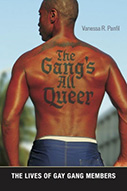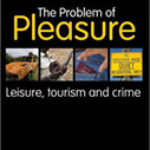THE GANG’S ALL QUEER: THE LIVES OF GAY GANG MEMBERS

Author: Vanessa R. Panfil
Publisher: New York: New York University Press, 2017. 288p.
Reviewer: James C. Howell | January 2018
This is a very important book because it expands the horizons of the gang field. Not long ago, “most typically, [the media stereotype was] that gangs are composed of late-adolescent males, who are violent, drug- and alcohol-soaked, sexually hyperactive, unpredictable, confrontational, drug-dealing criminals . . . They are demonic, and all the worse for being in a group” (Moore, 1993, p. 28). Vanessa Panfil’s pioneering research makes a valuable contribution to the increasing realization that—with the passing of time—youth/street gangs take many forms inside more homogenized urban settings. Indeed, Panfil provides an in-depth understanding of how, for gay gang members—unlike straight gangs that typically pull in heterosexual youth “for protection”—gay identity is the organizing characteristic.
Panfil’s research method is both ethnographic and experimental—using a snowball sampling design. She conducted in-depth interviews with 48 gang-involved participants in Columbus, Ohio. Their mean age was 21.5. (Panfil notes that Columbus young men typically joined gay gangs at age 18, roughly five years later than heterosexual boys.) Nearly half of them were employed. Nearly 60% had sold drugs, and a similar proportion had sold sex, and over half had done both. What may come as a surprise is that a significant proportion used markers of masculinity such as physical toughness and fighting skills to defend stigmatized sexual identity. Over three-quarters had been arrested, and over half had been incarcerated. In these respects, Panfil’s research provides a sharp contrast with the first gang members found in Columbus, Ohio in the 1980s by Ron Huff.
Once Panfil had achieved a comfortable level of acceptance in the Columbus gay scene, she became well acquainted with members of three virtually all-gay gangs, and the essence of these gangs varied in some interesting ways. The Boys of Bang—also known as B.o.B—was the most notorious, feared, and loathed gay clique in the city. With 10-12 core members, the Boys of Bang were reputed to be fierce fighters, capable of doing “major damage” to people and property over minor interpersonal slights. The Royal Family had 15-20 members, 10 of whom were actively involved in the group’s activities. Although this gang fought on occasion, their modus-operandi was based largely on their competitive dancing skills in the semi-competitive underground ballroom scene that connected several urban areas’ gay populations. A bit smaller, the Firing Squad had 10-15 members. Formerly feared for their fighting skills, this gang no longer fought frequently, yet they were the least entrenched in the “drama” of Columbus’s “ghetto gay scene.” Somewhat unique, this gang had an auxiliary straight female group that hung out with them and fought alongside on occasion.
Panfil set out to challenge existing heterosexist assumptions in criminology; tackling head-on basic questions such as who can be a gang member, and how crime, violence, and gang membership can produce avenues for constructing gay identities. She was quite successful in this enterprise, and along with the work with her colleague Dana Peterson, her book is an important contribution to our understanding of the expanding raison d’être of gang membership.
Huff, C. R. (1989). Youth gangs and public policy. Crime and Delinquency, 35, 524-537.
Moore, J. W. (1993). Gangs, drugs, and violence. In S. Cummings & D. J. Monti (Eds.), Gangs (pp. 27–46). Albany: State University of New York Press.
Peterson, D., & Panfil, V. A. (2017). Toward a multiracial feminist framework for understanding females’ gang involvement. Journal of Crime and Justice, 40, 337-357.


